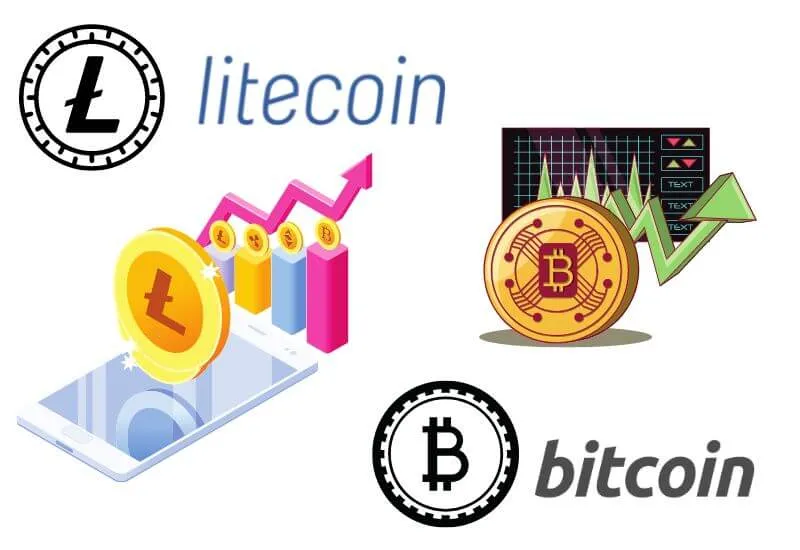LTC and BTC: 7 Differences Between Litecoin vs Bitcoin – The main important differences between (LTC) Litecoin and Bitcoin (BTC) can be counted as the coin limit, algorithm, market release date, mining reward halves, and mining process.
Of course, these differences need to be considered comprehensively.In this article, we will present to you all aspects of LTC and BTC, which also have differences in terms of transactions.
Table of Contents
Total Supply Difference
LTC and BTC have differences in terms of coin limits. Bitcoin’s coin market cap is capped at 21 million. Litecoin , the supply limit is set at 84 million.In this context, the coin limit for Litecoin is higher than BTC.
Algorithm Different
LTC and BTC algorithms are different from each other. The Bitcoin algorithm works on SHA-256. The Litecoin algorithm, on the other hand, works on the Script system.
In Bitcoin’s SHA-256 algorithm, an output of 64 characters always occurs in the hexadecimal number system, even if the input data is quite long.Litecoin script algorithm, on the other hand, is an algorithm that precedes the SHA-256 algorithm and offers faster transaction confirmation.
Block Creation Time Is Different
The differences between Litecoin and Bitcoin also arise in matters that concern miners.While the average time for a block to occur for transactions made with BTC is 10 minutes, the time for LTC blocks to occur is 2.5 minutes.
In this context, it is stated that blocks are formed faster for Litecoin transactions. Faster transaction confirmation and reduced difficulty for miners are reflections of this block formation rate.
For those who are interested in a deeper understanding of these differences and their implications on the broader cryptocurrency market, including practical trading insights,tradetaurex.comoffers a comprehensive resource. This site delves into various aspects of cryptocurrency trading, providing valuable information for both beginners and seasoned traders.
Mining Reward Halving Different
While LTC and BTC miners approve transactions, the amount of rewards they receive within certain time periods is halved.In this way, the supply limit, which should not exceed the coins, is kept under control. However, the halving causes miners to lose their earnings.
BTC miners’ rewards are halved every 210,000 blocks. LTC miners’ rewards are halved every 840,000 blocks. LTC and BTC, whose block halving criteria are different, also differ in the reward value they offer in the halving. When the halving is seen, LTC offers more profits than BTC to the miner.
Difference in Release Date
Bitcoin emerged on January 3, 2009. Litecoin was launched on October 7, 2011.In this respect, Bitcoin is seen as the first and leading cryptocurrency.Litecoin, on the other hand, counts as an altcoin as it enters the market later.
Transaction Differences Between LTC and BTC
Here are the transaction differences between Litecoin and Bitcoin:
- Litecoin can handle higher volume transactions thanks to faster block generation.
- If Bitcoin had the goal of catching up with Litecoin’s transaction speed, it would have to make radical changes to the software.
- The Litecoin blockchain covers a larger area than the Bitcoin blockchain. This is because the block processing capacity also expands the space.
- A person who trades with Litecoin waits for 5 minutes to see that their two transactions have been verified.
- Investor investing with Bitcoin should wait an average of 10 minutes just to see that a transaction has been verified.
BTC and LTC Mining Differences
In BTC mining , the use of ASIC chips is at the forefront.The hash algorithm is known as SHA-256.The performance for this algorithm is enhanced by the use of parallel processors and chips. That’s why ASIC has already appeared on the chip.
However, in this model, the algorithm difficulty level increases and the block generation and approval stages for the miner are more difficult than those in Litecoin mining conditions.
In Litecoin mining, the basis is RAM power.LTC mining uses the scrypt algorithm. In this algorithm, a single base processor power does not have to be used. High speed RAM support is taken. This allows the miner to make block confirmations more easily. It also reduces mining costs one click.
As a result
Bitcoin is known as the father of all cryptocurrencies as the first cryptocurrency.Litecoin, on the other hand, is one of the first known hard forks of Bitcoin. To put it more clearly, the Litecoin network was produced by copying and developing Bitcoin codes.
Therefore, it is more advanced than Bitcoin with many features. Of course, it is not enough just to have good features in this market. The most important difference between BTC and LTC is the amount of awareness and trading volume.


